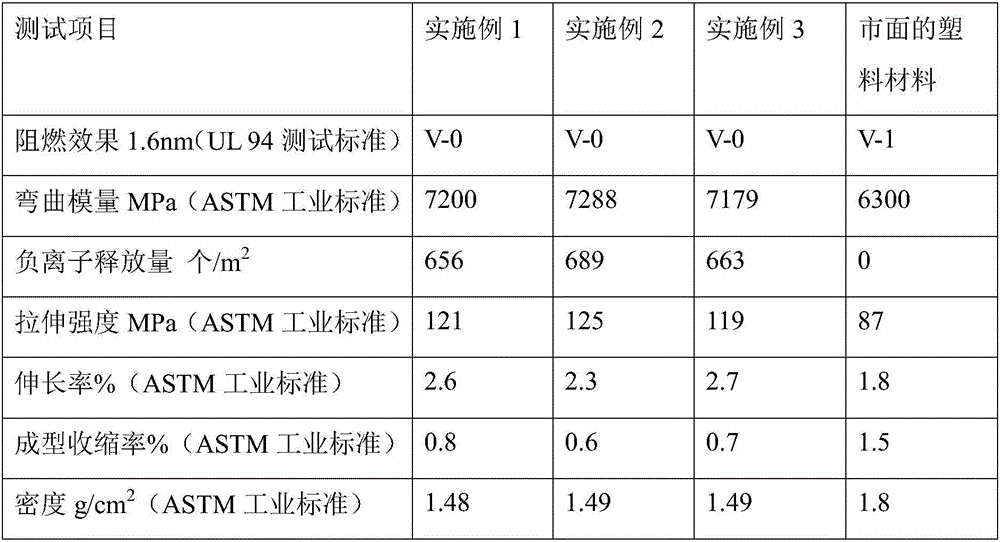Plastic material for electronic product shell and processing method thereof
A technology of electronic products and processing methods, applied in the field of plastic materials for electronic products, can solve the problems of poor anti-aging performance, small bonding force, easy to become brittle, etc., and achieve good waterproof performance, improve wear resistance, and improve compatibility. Effect
- Summary
- Abstract
- Description
- Claims
- Application Information
AI Technical Summary
Problems solved by technology
Method used
Image
Examples
Embodiment 1
[0027] A plastic material used for electronic product housings, in parts by weight, the raw materials used include:
[0028] 180 parts of polylactic acid, 50 parts of polycarbonate, 50 parts of polystyrene, 55 parts of methyl methacrylate-acrylic acid copolymer, 35 parts of ABS plastic, C 15 35 parts of fatty primary amine, 20 parts of biomass material, 22 parts of bamboo charcoal particles, 15 parts of zinc borate, 18 parts of diatomite, 18 parts of vinyl bis stearamide, 10 parts of sodium lauryl sulfate, 10 parts of glycerin parts, 10 parts of grease, 9 parts of plasticizer, 8 parts of chlorinated phosphazene, 8 parts of white carbon black, 8 parts of ginger oleoresin, and 6 parts of pigment; among them,
[0029] The plasticizer includes dioctyl phthalate with a mass ratio of 1:1:2:1:2, phthalates, acetyl tributyl citrate, phenyl alkylsulfonate and tricitrate butyl fat.
[0030] The plastic material used for the housing of electronic products, the plasticizer is obtained b...
Embodiment 2
[0042] A plastic material used for electronic product housings, in parts by weight, the raw materials used include:
[0043] 190 parts of polylactic acid, 55 parts of polycarbonate, 55 parts of polystyrene, 56 parts of methyl methacrylate-acrylic acid copolymer, 38 parts of ABS plastic, C 1834 parts of fatty primary amine, 22 parts of biomass material, 23 parts of bamboo charcoal particles, 16 parts of zinc borate, 19 parts of diatomaceous earth, 19 parts of vinyl bis stearamide, 12 parts of sodium lauryl sulfate, 11 parts of glycerin parts, 11 parts of grease, 10 parts of plasticizer, 9 parts of chlorinated phosphazene, 9 parts of white carbon black, 9 parts of ginger oleoresin, and 7 parts of pigment; among them,
[0044] The plasticizer includes dioctyl phthalate with a mass ratio of 1:1:2:1:2, phthalates, acetyl tributyl citrate, phenyl alkylsulfonate and tricitrate butyl fat.
[0045] The plastic material used for the housing of electronic products, the plasticizer is o...
Embodiment 3
[0057] A plastic material used for electronic product housings, in parts by weight, the raw materials used include:
[0058] 200 parts of polylactic acid, 60 parts of polycarbonate, 50-60 parts of polystyrene, 60 parts of methyl methacrylate-acrylic acid copolymer, 40 parts of ABS plastic, C 15-20 35-38 parts of fatty primary amine, 23 parts of biomass material, 25 parts of bamboo charcoal particles, 18 parts of zinc borate, 20 parts of diatomite, 20 parts of vinyl bis stearamide, 13 parts of sodium lauryl sulfate, 12 parts of glycerin, 12 parts of lubricating grease, 11 parts of plasticizer, 10 parts of chlorinated phosphazene, 10 parts of white carbon black, 10 parts of ginger oleoresin, 8 parts of pigment; among them,
[0059] The plasticizer includes dioctyl phthalate with a mass ratio of 1:1:2:1:2, phthalates, acetyl tributyl citrate, phenyl alkylsulfonate and tricitrate butyl fat.
[0060] The plastic material used for the housing of electronic products, the plasticize...
PUM
| Property | Measurement | Unit |
|---|---|---|
| Particle size | aaaaa | aaaaa |
| Thickness | aaaaa | aaaaa |
| Particle size | aaaaa | aaaaa |
Abstract
Description
Claims
Application Information
 Login to View More
Login to View More - R&D
- Intellectual Property
- Life Sciences
- Materials
- Tech Scout
- Unparalleled Data Quality
- Higher Quality Content
- 60% Fewer Hallucinations
Browse by: Latest US Patents, China's latest patents, Technical Efficacy Thesaurus, Application Domain, Technology Topic, Popular Technical Reports.
© 2025 PatSnap. All rights reserved.Legal|Privacy policy|Modern Slavery Act Transparency Statement|Sitemap|About US| Contact US: help@patsnap.com

